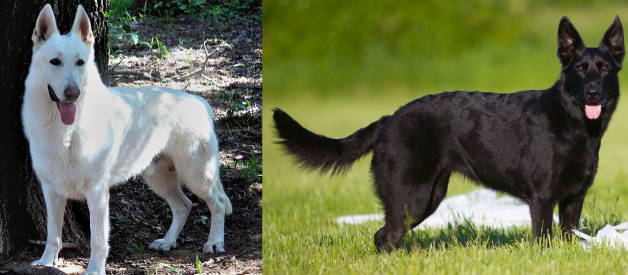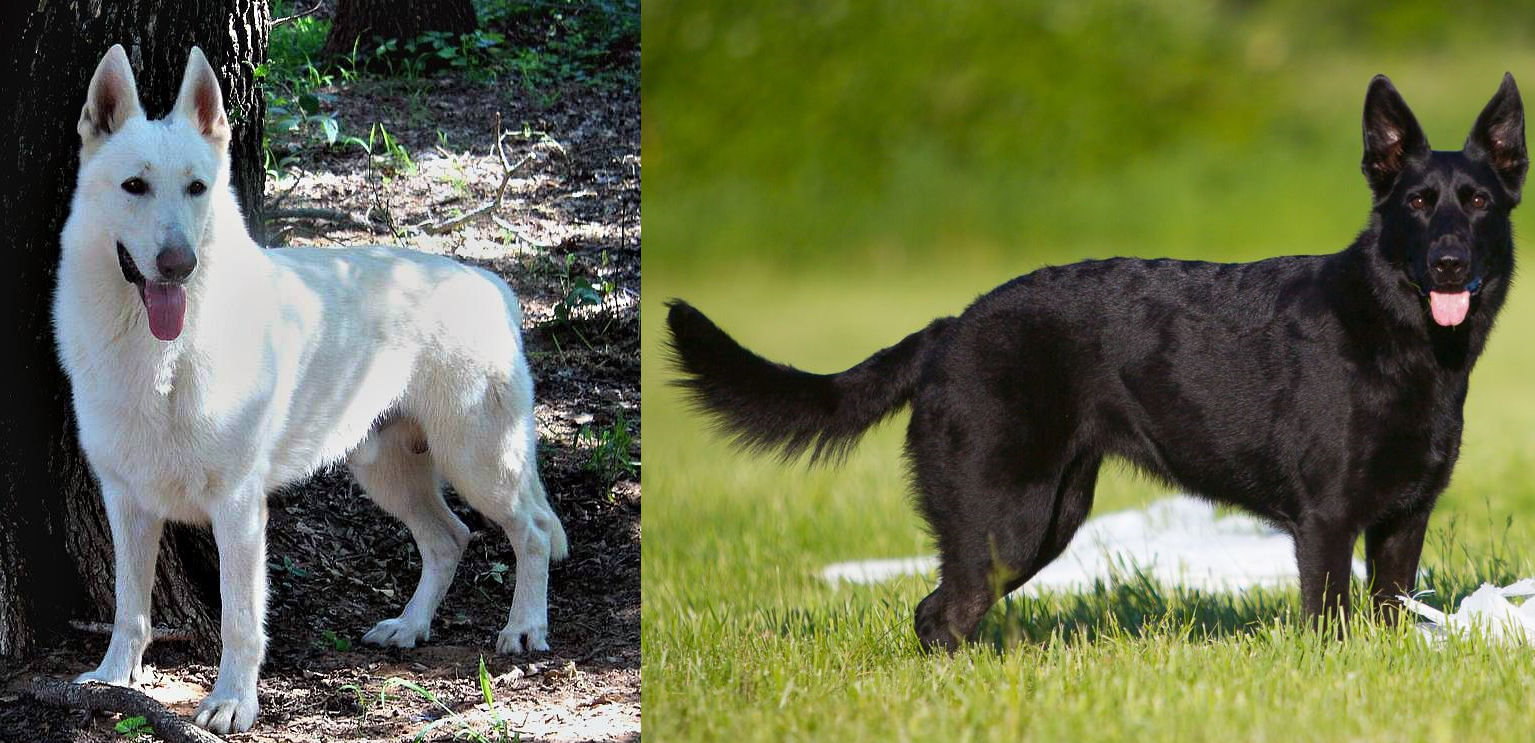 Our example dogs, Mancos (male, white GSD) and Bailey (female, black GSD)
Our example dogs, Mancos (male, white GSD) and Bailey (female, black GSD)
This question comes up from time to time, and if you don?t have much knowledge of how the genetics of German Shepherds? coats work, it?s a fun thought exercise! The reality though is that it?s one of those simple questions with a really complicated answer and without genetic testing, difficult to predict.
A note about responsible and ethical breeding
German Shepherds, like many other breeds, have a number of genetic diseases or predispositions that need to be taken in to account when breeding. At a bare minimum, both parents should have their hips x-rayed and certified by an expert panel such as the Orthopedic Foundation for Animals (OFA), SV (the German Shepherd registry in Germany) or a PennHip certified Veterinarian. According to OFA, about 20% of GSDs carry Degenerative Myelopathy (DM). A $45 DNA test can tell you if a given dog carries for this, and there is no reason to ever breed 2 dogs without knowing if they carry for this disease.
Don?t just breed because you?re curious what the puppies will look like. The price of DNA testing has come way, way down and it is possible to answer the question of ?What colors would I get if I bred my dog?? for about $120 via DNA tests, or for FREE if you know enough about the parents of each dog!
What controls a GSD?s color or coat pattern?
Genetics! For today?s discussion, we only need a very basic understanding of genetics. If you scroll down, you?ll find a primer on the with the details, or you can browse the awesome, illustrated website DogGenetics.co.uk for a complete guide (which is how I learned).
For the purposes of our discussion, 2 genes matter the most:
- Agouti, referred to as the A Locus, which has 4 possible alleles/versions (3 of which exist in German Shepherds)
- Extension or Masking gene, referred to as the E Locus, which has 3 possible alleles/versions.
Here are the important versions of each, listed in Dominance order from top to bottom:
 Looking for the B, D and K loci? I?ll mention them later (and Panda). If you?ve already picked up that these are missing, you?ll probably grumble about creeping tan, the intensity locus and bleed through later. I do explain these eventually, but they would explode the possible combinations out beyond reason.
Looking for the B, D and K loci? I?ll mention them later (and Panda). If you?ve already picked up that these are missing, you?ll probably grumble about creeping tan, the intensity locus and bleed through later. I do explain these eventually, but they would explode the possible combinations out beyond reason.
The way inheritance works is that each parent donates 1 copy of each gene to a puppy. So if a parent has one Em and one E, they will give one or the other to each puppy they produce. Whether a given puppy gets Em or E is a coin flip, completely random and independent for each individual puppy. To phrase this another way, each puppy gets 1 copy of the gene from their sire and 1 copy from their dam.
What do the dominance orders mean? They tell you how the 2 copies a given dog has interact. If a dog has 2 different versions of a gene, the one higher on the order wins out*. This means that in order for a dog to express the version lowest in the order, they must have 2 copies of it.
*The A Locus is a little bit special, in that lower order dominance versions sometimes interact with higher order ones. A prime example of this is with Sable GSDs, where a dog with aw/aw or aw/at is generally lighter in overall color than a dog with aw/a. A dog with aw/a is typically referred to as Dark Sable.
Why is a white German Shepherd white?
A white German Shepherd is white because on the E Locus, they have 2 copies of e which means they can?t produce black pigment (Eumelanin) in their coat. Additionally, their ?Intensity Locus? prevents them from producing red or tan (Phaeomelanin). Some white dogs have a little bit of cream, or small patches of tan. These are areas where they are still producing just a little bit of Phaeomelanin. Phaeomelanin itself is actually a red pigment, the shade we see on a tan dog is caused by how much of the pigment they are able to produce.
This means that the A Locus on a white German Shepherd is unknown without a genetic test or multiple litters.
Want to know more? Scroll down to A Quick Primer on Dog Coat Genetics or visit the website http://www.doggenetics.co.uk
Why is a black German Shepherd black?
A black German Shepherd is black because their A Locus has 2 copies of the recessive black allele (a) and their E locus has at least one copy of E or Em. In short hand, their A locus is noted as a/a. Additionally, because this dog is not white, we know that their E Locus has at most one copy of e but that is all we know for sure. We don?t know if this dog has a Mask, No Mask or carries for ?recessive red?.
Want to know more? Scroll down to A Quick Primer on Dog Coat Genetics or visit the website http://www.doggenetics.co.uk
Ok, so what would the puppies look like?
Ok, so back to our sample 2 dogs from the top. What do we know about their genetics now?
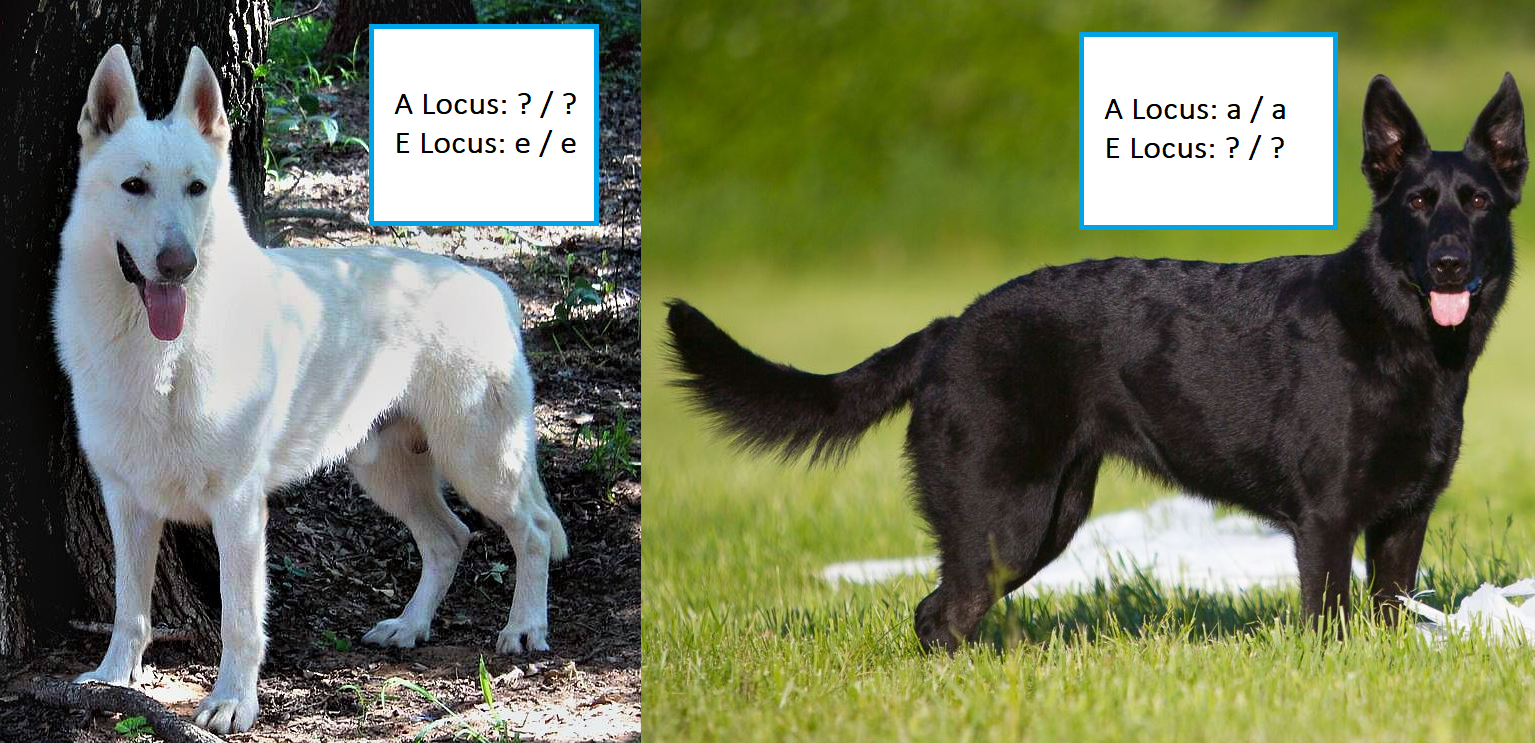 Kind of like Sudoku! What could their missing genes be?
Kind of like Sudoku! What could their missing genes be?
White dog A Locus options: aw/aw, aw/a, aw/at, at/at, at/a, a/a
Black dog E Locus options: Em/Em, Em/E, Em/e, E/E, E/e (why not e/e? Because then black dog would be white or solid tan!)
And this is where it gets interesting. All of those possible options mean a HUGE number of possible outcomes!
Let?s handle the common/?normal? cases first
We?re going to take some shortcuts:
- There are quite a few very interesting but less common variations to this story that I?m not going to break out in full detail, including colors like liver, blue, Isabella and white spotting in the form of Panda. I?ll explain how they work further down.
- I?m also going to skip E, or maskless, as it?s pretty rare in German Shepherds. The majority of German Shepherd Dogs are Em/Em, with Em/e or e/e showing up in White Shepherd lines. We?re going to use this to ?cheat? and reduce the number of possible outcomes. We know that the black dog CAN?T be e/e, otherwise they?d be white or solid tan, so we?re going to say black dog could only be Em/Em or Em/e.
- A note about Intensity: I?m going to label all of the aw/a puppies as Dark Sable and the e/e puppies as White, however in both cases the Intensity locus could mean these aren?t correct. I?ll explain more later.
What if these 2 dogs are?
The charts below each picture are the possible outcomes for the puppies and what % chance each outcome has.
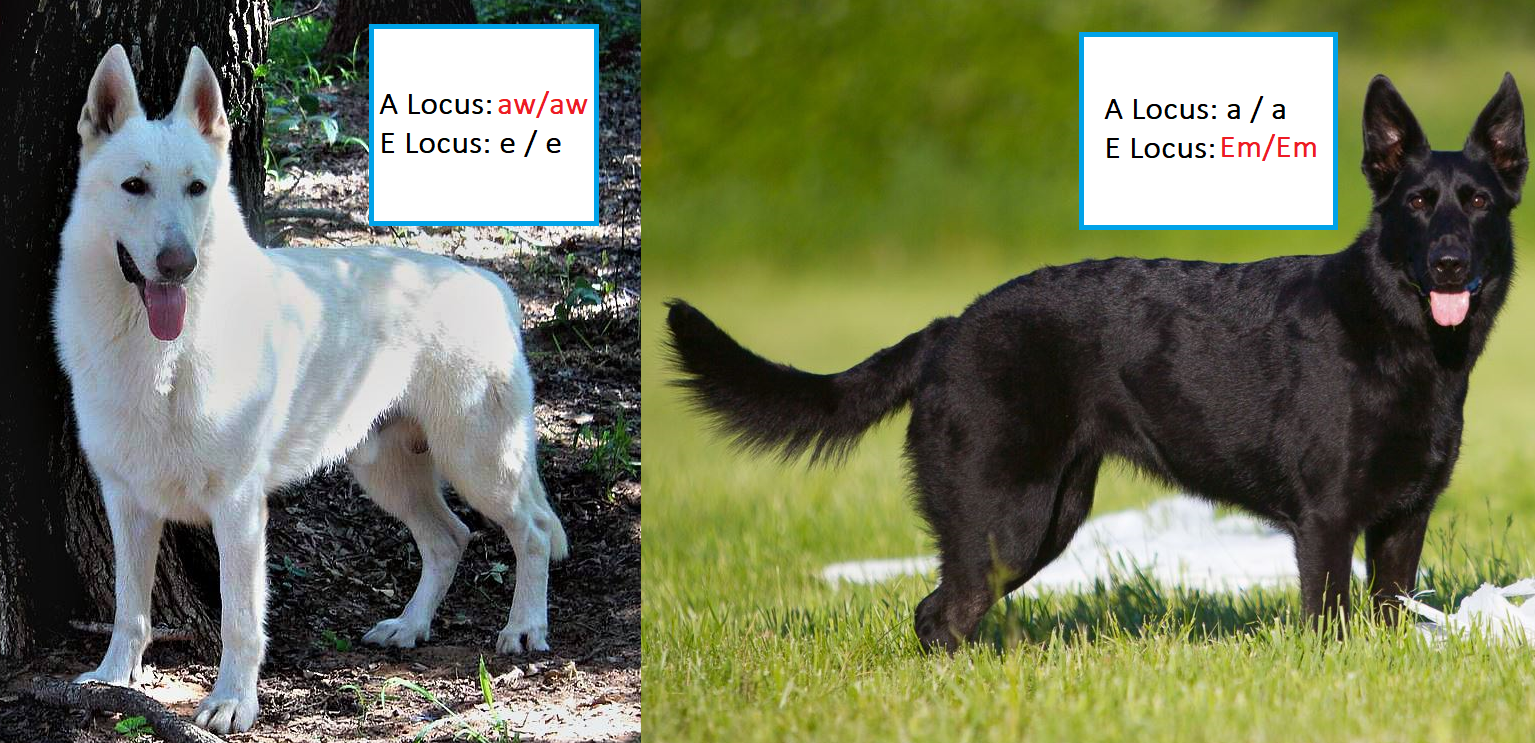 What if white dog is aw/aw and black dog is Em/Em?
What if white dog is aw/aw and black dog is Em/Em? Dark sables! Easy enough
Dark sables! Easy enough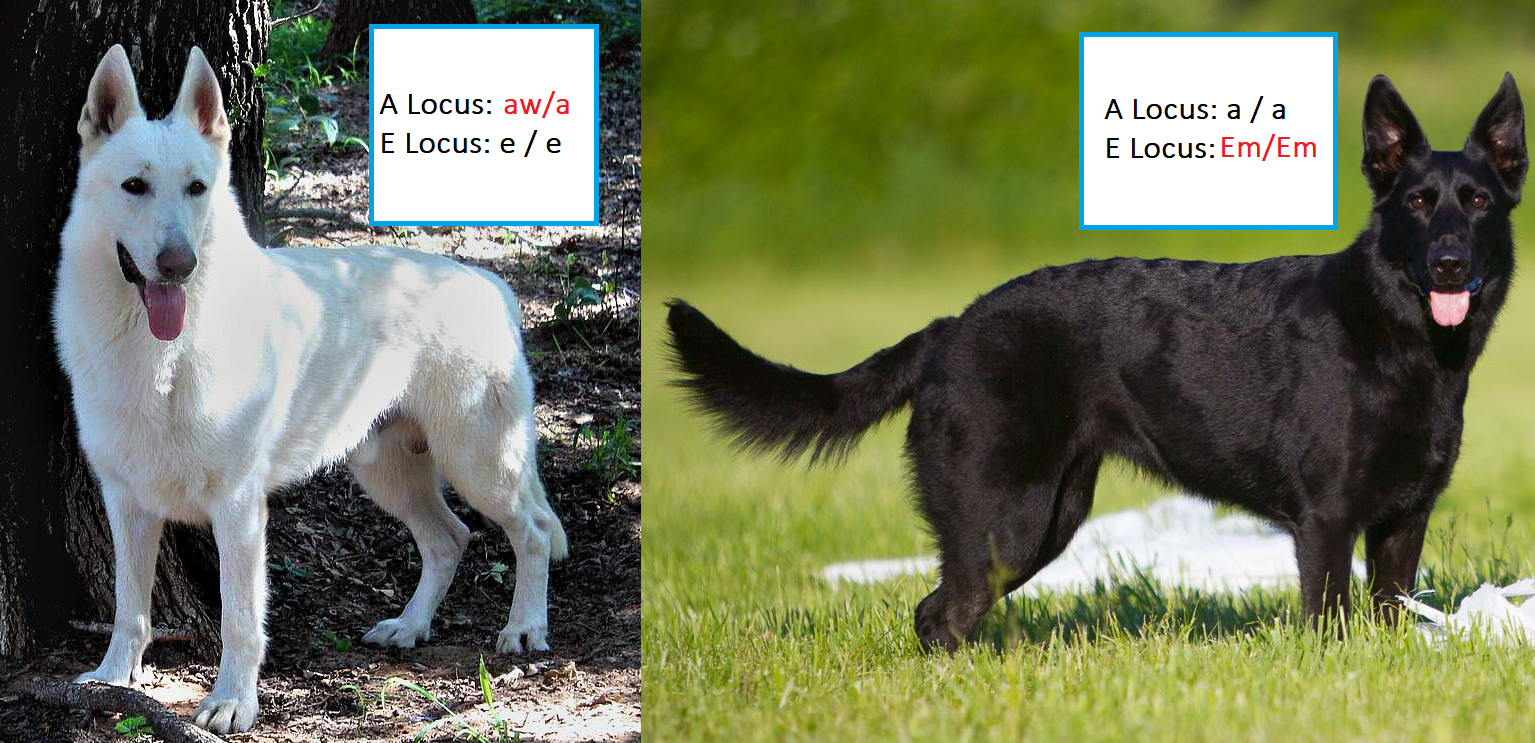 What if white dog is aw/a and black dog is Em/Em?
What if white dog is aw/a and black dog is Em/Em? Solid Black or Dark Sable!
Solid Black or Dark Sable!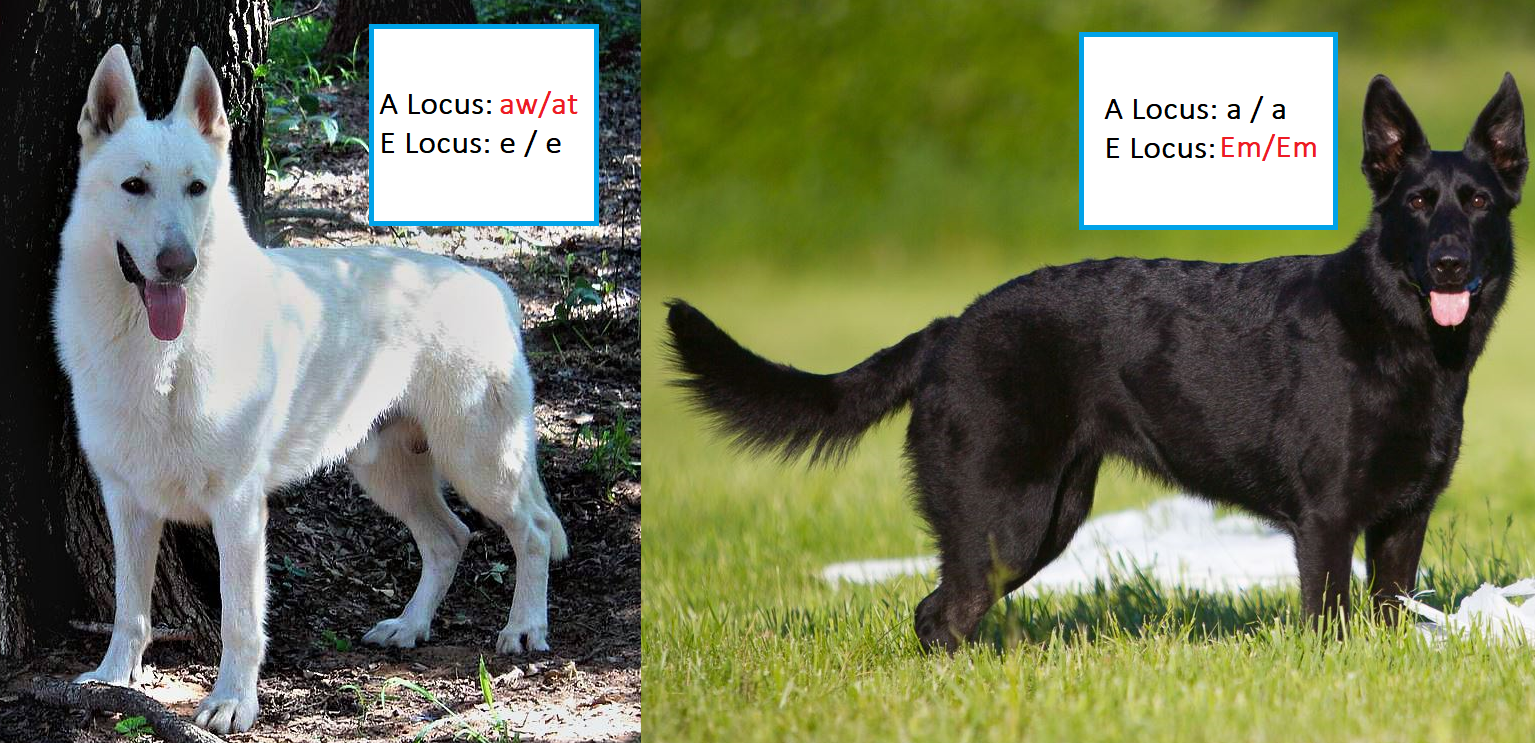 What if white dog is aw/at and black dog is Em/Em?
What if white dog is aw/at and black dog is Em/Em? Black and Tans! Dark Sables!
Black and Tans! Dark Sables!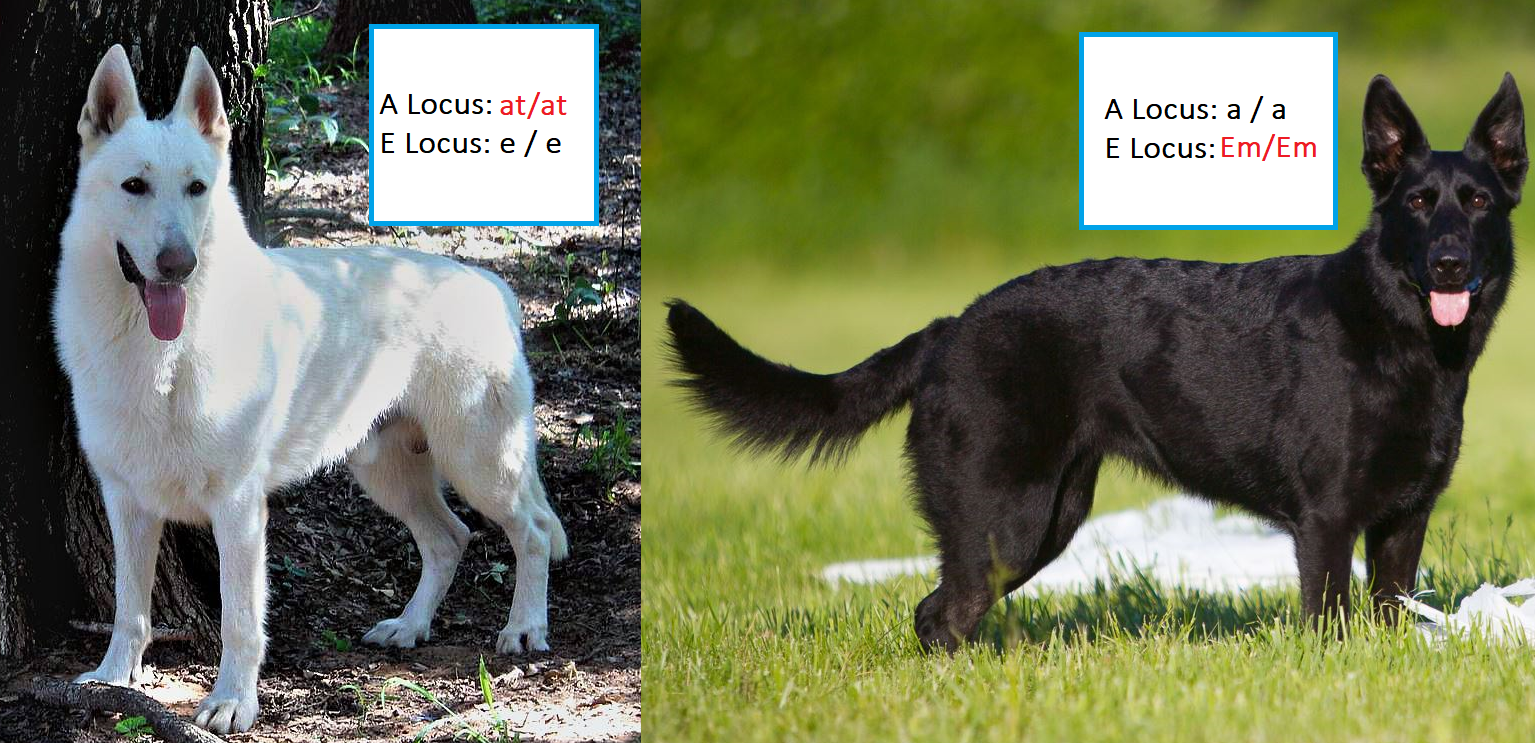 What if the white dog is at/at and the black dog is em/em?
What if the white dog is at/at and the black dog is em/em? All black & tans!
All black & tans!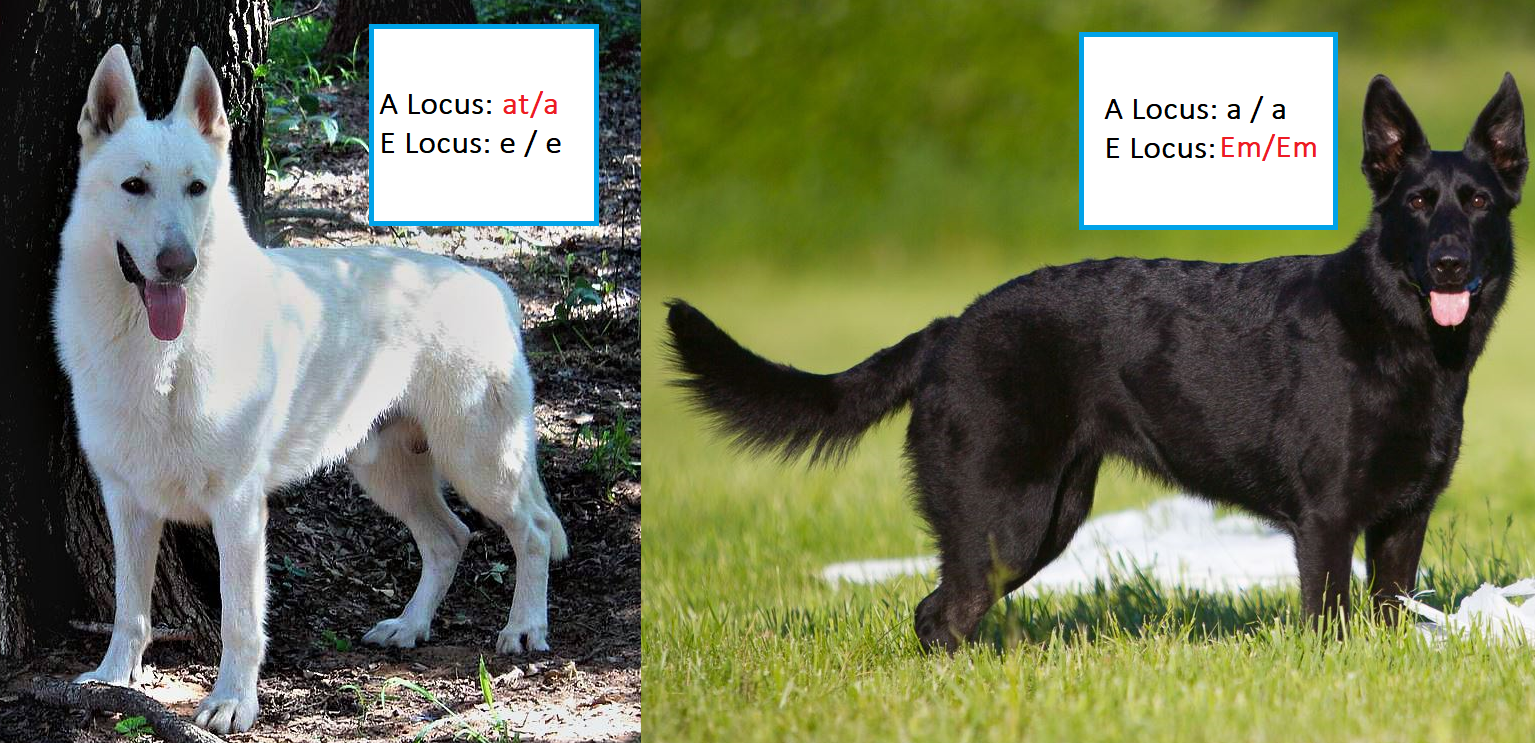 What if the white dog is at/a and the black dog is Em/Em?
What if the white dog is at/a and the black dog is Em/Em? Black & Tans and solid black!
Black & Tans and solid black!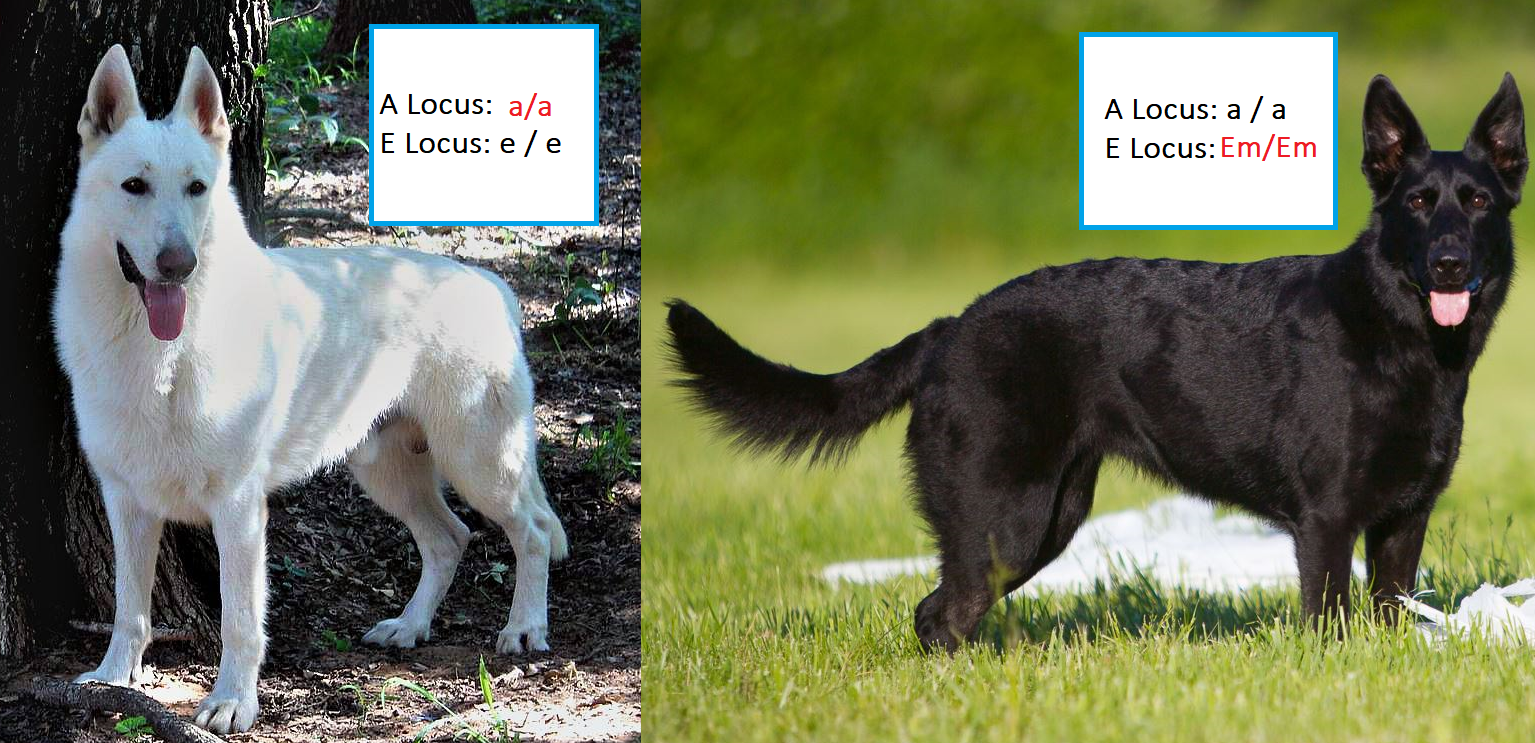 And what if the white dog is a/a while the black dog is Em/Em
And what if the white dog is a/a while the black dog is Em/Em All solid black puppies!
All solid black puppies!
So if black dog has Em/Em, we had 3 possibilities: Solid Black, Black & Tan, or Dark Sable. Neat! But it gets a lot more interesting if the black dog carries e as well. Now, we?re going to assume that when black dog carries e, she is also carrying for very light or white Phaeomelanin.
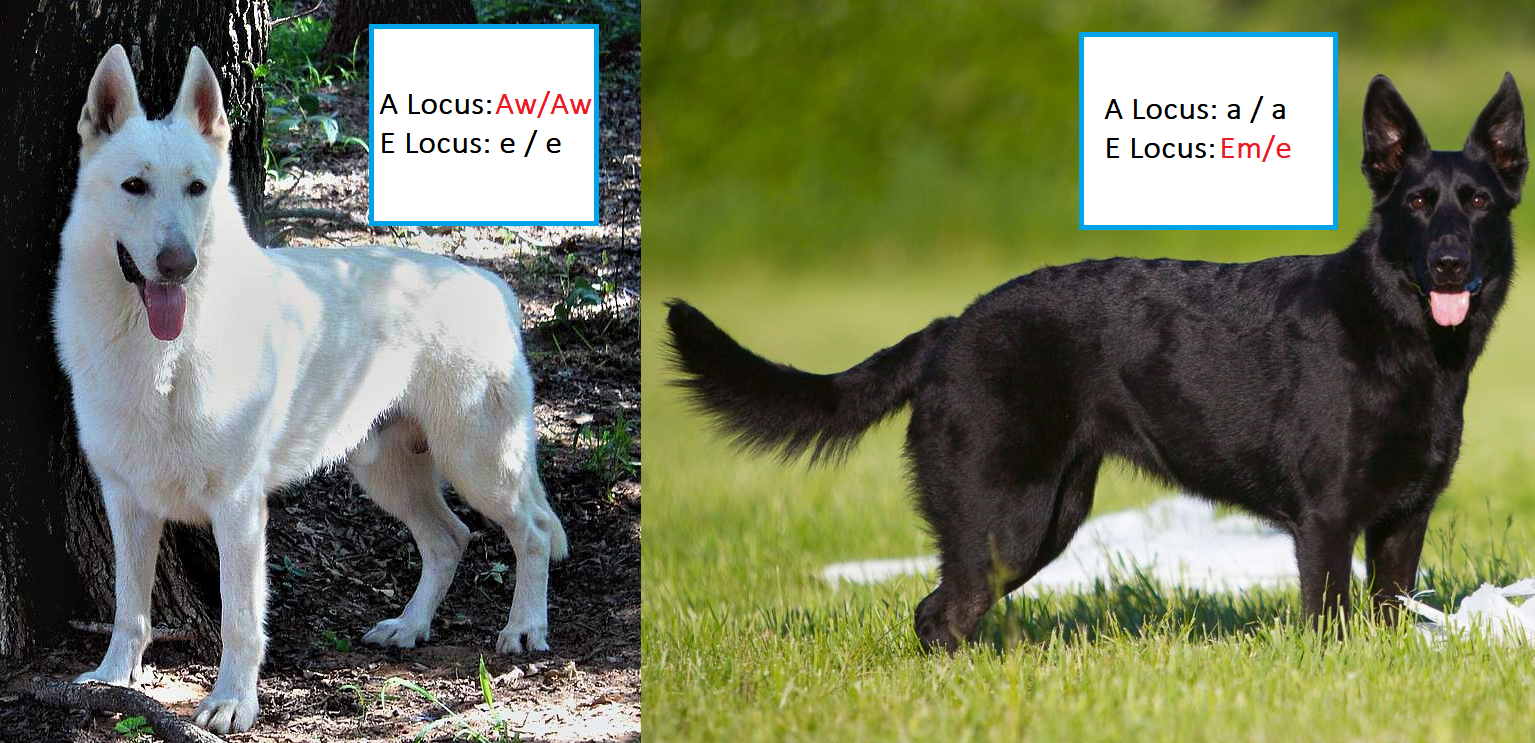 Now it gets interesting. What if white dog is aw/aw and black dog is Em/e? Sorry about the typo in the image, white dog is supposed to be aw/aw not Aw/Aw.
Now it gets interesting. What if white dog is aw/aw and black dog is Em/e? Sorry about the typo in the image, white dog is supposed to be aw/aw not Aw/Aw. Whoa! 50/50 chance of white or dark sable!
Whoa! 50/50 chance of white or dark sable!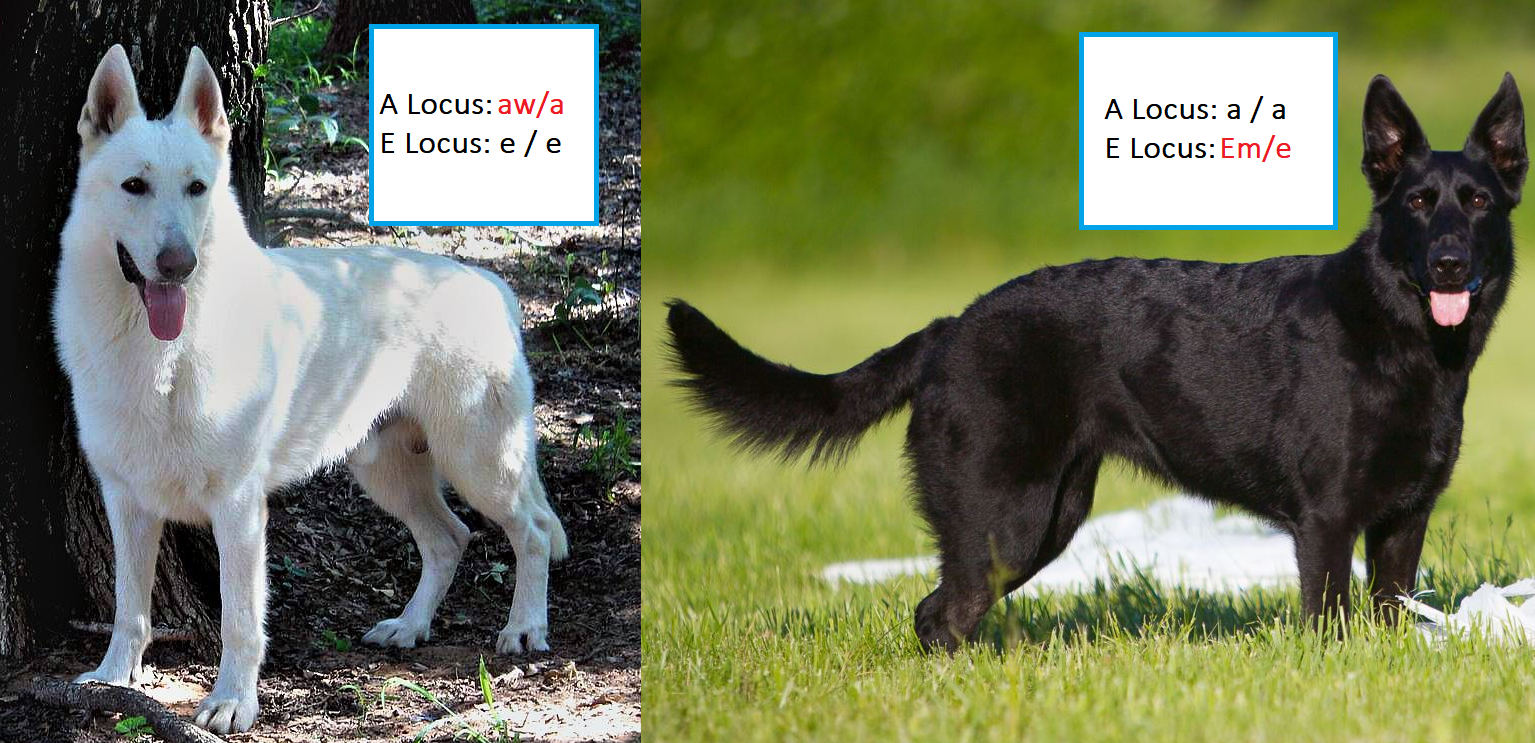 And what if the white dog is aw/a and the black dog is Em/e?
And what if the white dog is aw/a and the black dog is Em/e? Dark Sable, White or solid black! Silver Sable is possible depending on the Intensity Locus as well. For more information, read the section of the Intensity Locus as well
Dark Sable, White or solid black! Silver Sable is possible depending on the Intensity Locus as well. For more information, read the section of the Intensity Locus as well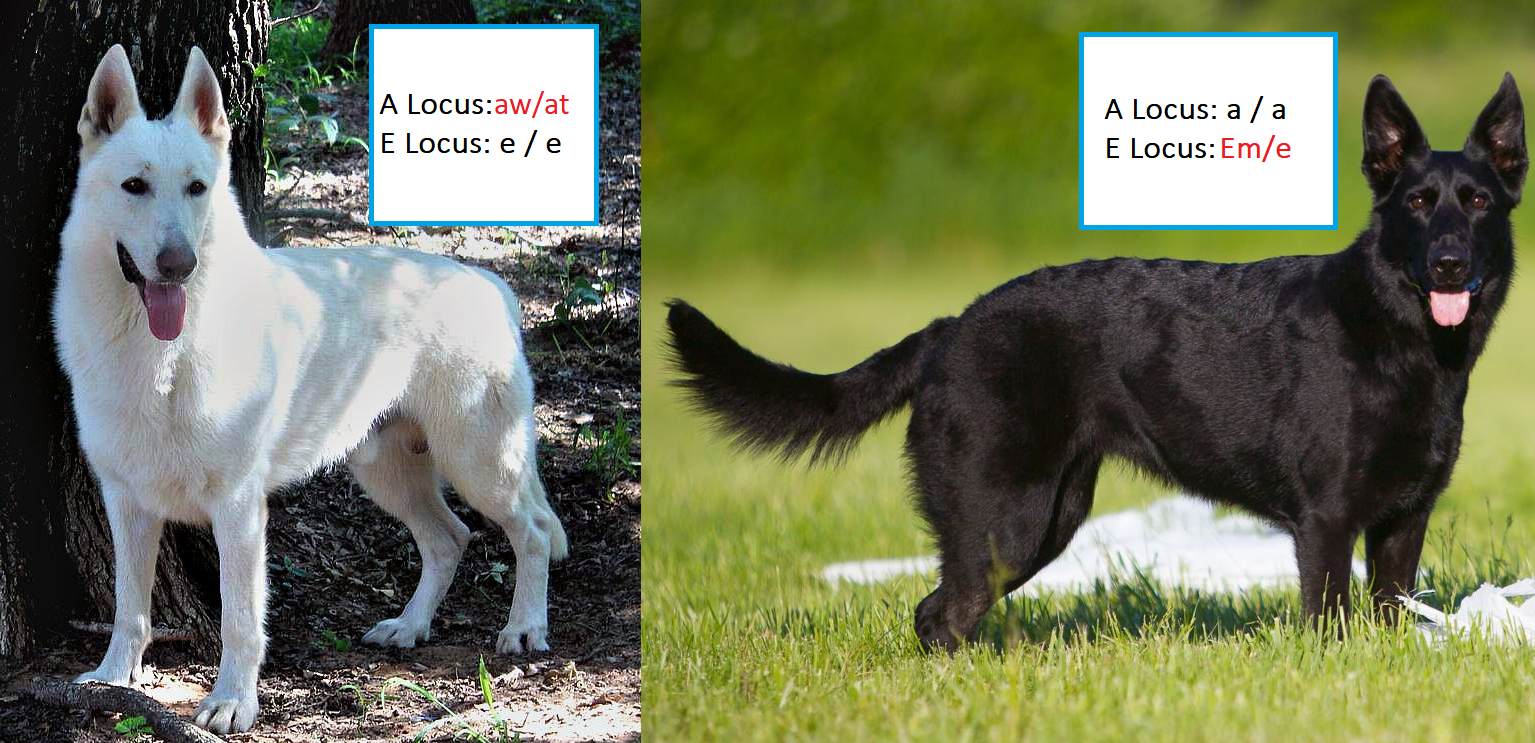 What if the white dog is aw/at and the black Em/e?
What if the white dog is aw/at and the black Em/e? A 50% chance of being white, 25% chance of being Dark Sable and 25% chance of being Black and Tan!
A 50% chance of being white, 25% chance of being Dark Sable and 25% chance of being Black and Tan!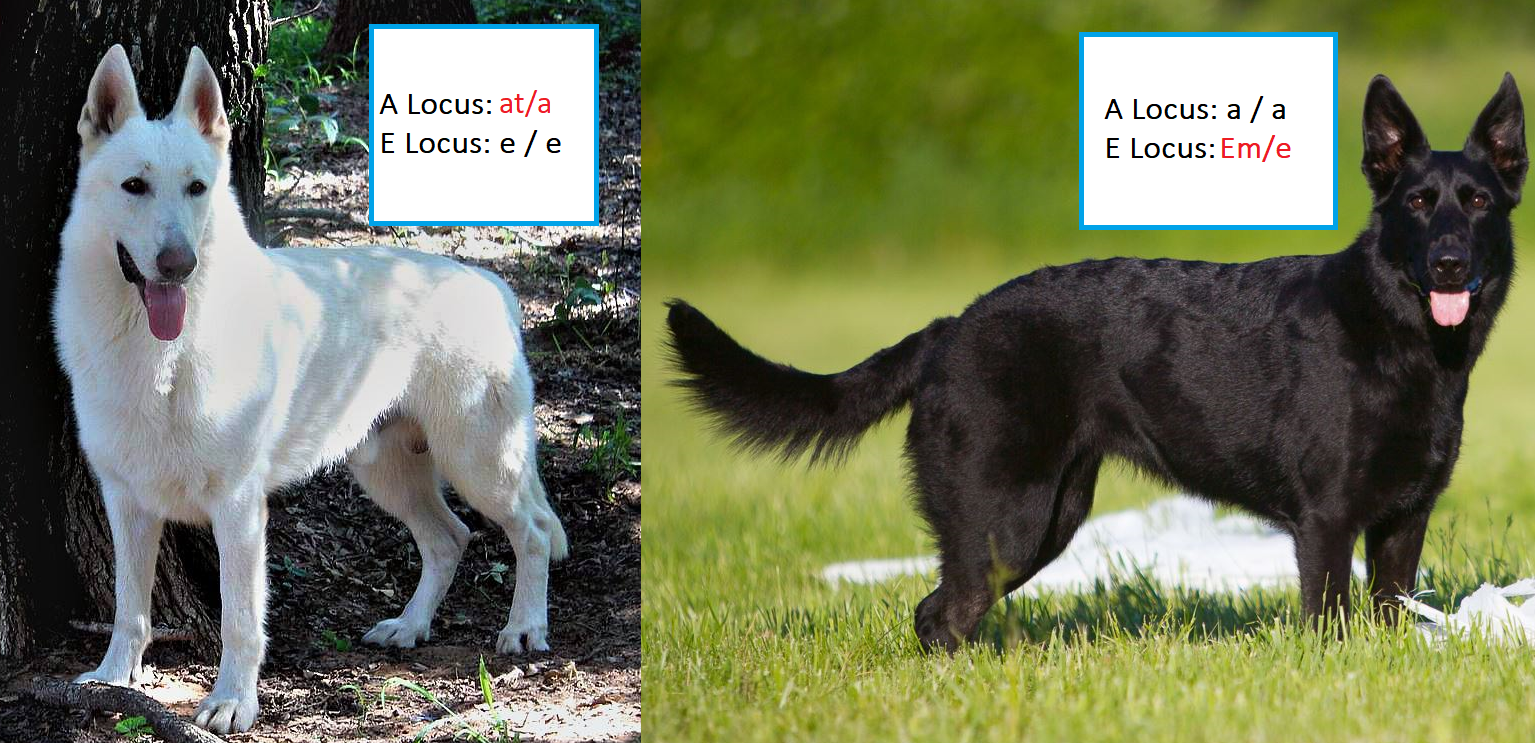 What if the white dog is at/a and the black dog Em/e?
What if the white dog is at/a and the black dog Em/e? Now things are getting a little weird. There?s a 50% chance any given puppy would be white, even though their A Locus would be different! A 25% chance of solid black and a 25% chance of being black and tan round out the possibilities
Now things are getting a little weird. There?s a 50% chance any given puppy would be white, even though their A Locus would be different! A 25% chance of solid black and a 25% chance of being black and tan round out the possibilities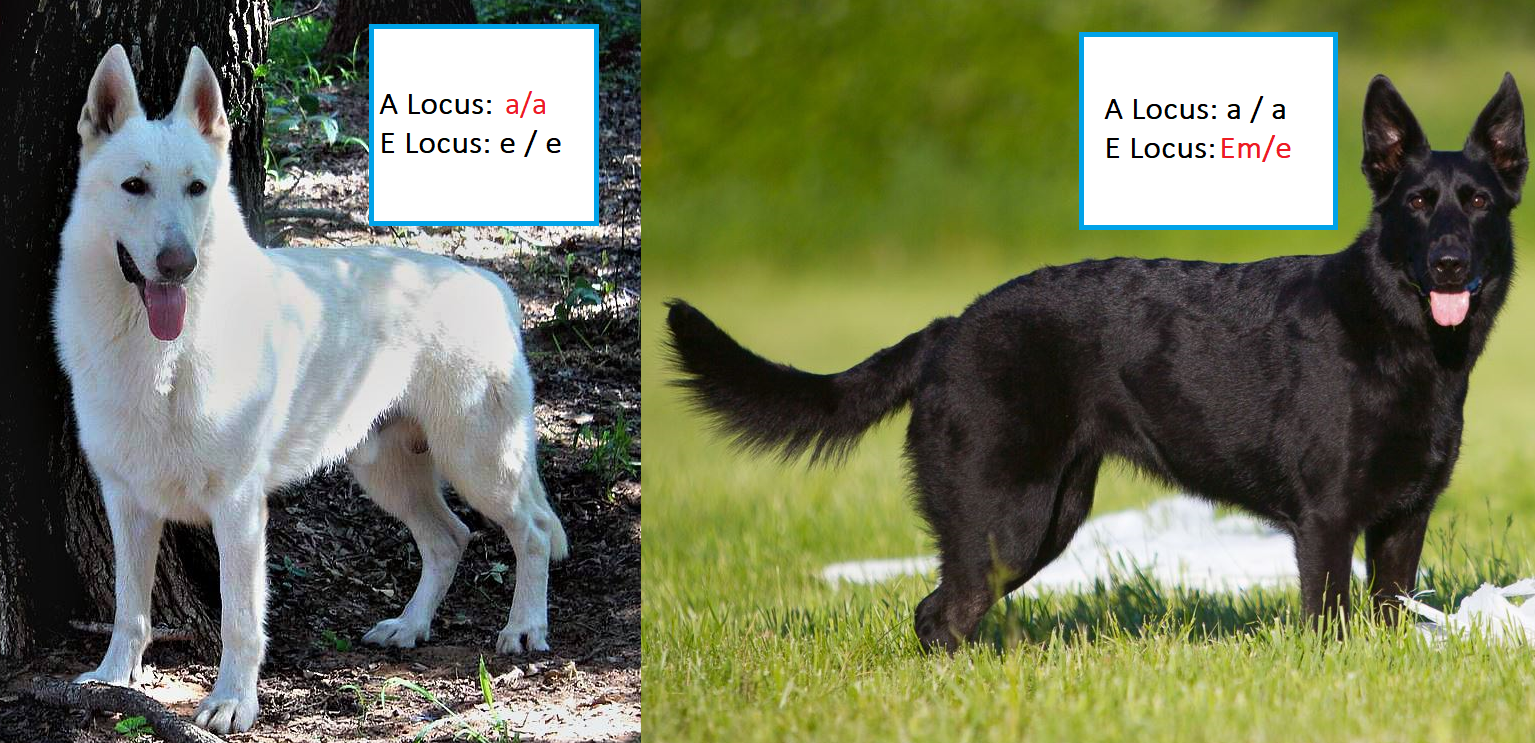 What if the white dog is at/a and the black dog Em/e?
What if the white dog is at/a and the black dog Em/e? A 50/50 shot of being solid black or solid white, neat!
A 50/50 shot of being solid black or solid white, neat!
So there you have it. In the majority of cases, breeding a white GSD to a black GSD would result in one of the above cases, but you can?t be sure which unless you?ve tested the A Locus of the white dog and the E Locus of the Black dog.
Now, as luck would have it, I happen to have Embark test results for the black dog:
Black Dog:
- A Locus: a/a
- E Locus: Em/Em
White Dog:
For the white dog, we don?t know for SURE because he hasn?t been tested, however based on litters he has produced he is almost certainly a/a. If you look at our possible permutations above, this means our made up pairing would produce only solid black puppies.
Now, let?s talk about some of those less common colors and patterns?
A note to the purists out there, yes, many of these are out of standard but frankly, so are white GSDs and you made it this far so don?t complain!
First, A Quick Primer About Dog Coat Genetics
Dogs are capable of producing 2 types of pigment: Eumelanin (black) and Phaeomelanin (red). All of the colors, patterns and variations we see in dogs are caused by these 2 pigments in varying quantities (including the lack of either, which is white).
So far, we?ve discussed the 2 genes most commonly responsible for the variations in color and pattern that we see in German Shepherds:
- The Agouti or A Locus, which controls the spread of Phaeomelanin.
- The Extension or E Locus, sometimes called the masking gene. It controls whether Eumelanin can be produced and influences where.
Each of these genes has several possible variations (the technical term is alleles). In German Shepherds, there are 3 variations for each with a dominance order that means they override one another. In short hand, upper case letters are used to indicate the top dominant alleles while anything below that is in lowercase.
 In Dominance order from top to bottom, here are the alleles (variations of the genes)
In Dominance order from top to bottom, here are the alleles (variations of the genes)
You?ll notice that none of the A Locus alleles listed above are upper case. That?s because the top dominant form of Agouti for all practical purposes doesn?t exist in German Shepherds. It?s noted as Ay, and in the breeds it occurs in (such as Belgian Malinois) it?s usually referred to as Fawn or Sable. Since in German Shepherds we call Agouti/aw Sable, it?s easier to leave Ay out of this discussion entirely.
Phaomelanin Intensity and the I Locus
So given the chart above, how could a German Shepherd ever be white? The answer is in the E Locus and another gene I?ve hinted at but haven?t explained, the Intensity or I Locus. This gene hasn?t actually been mapped yet, so we don?t know how many variations or alleles it has, or if it?s even a single gene! What we do know is that, in German Shepherds, there exists a recessive allele that significantly reduces the dog?s ability to produce Phaeomelanin (red), to the point where it appears white.
What makes the Intensity Locus interesting is that it ONLY impacts the production of Phaeomelanin (red). This means that if a dog is able to produce Eumelanin, it is regular black. This is why some German Shepherds are black and tan while others are black and red. On their A Locus, both are at/a or at/at, but their Intensity Locus impacts the amount of Phaeomelonin they can produce.
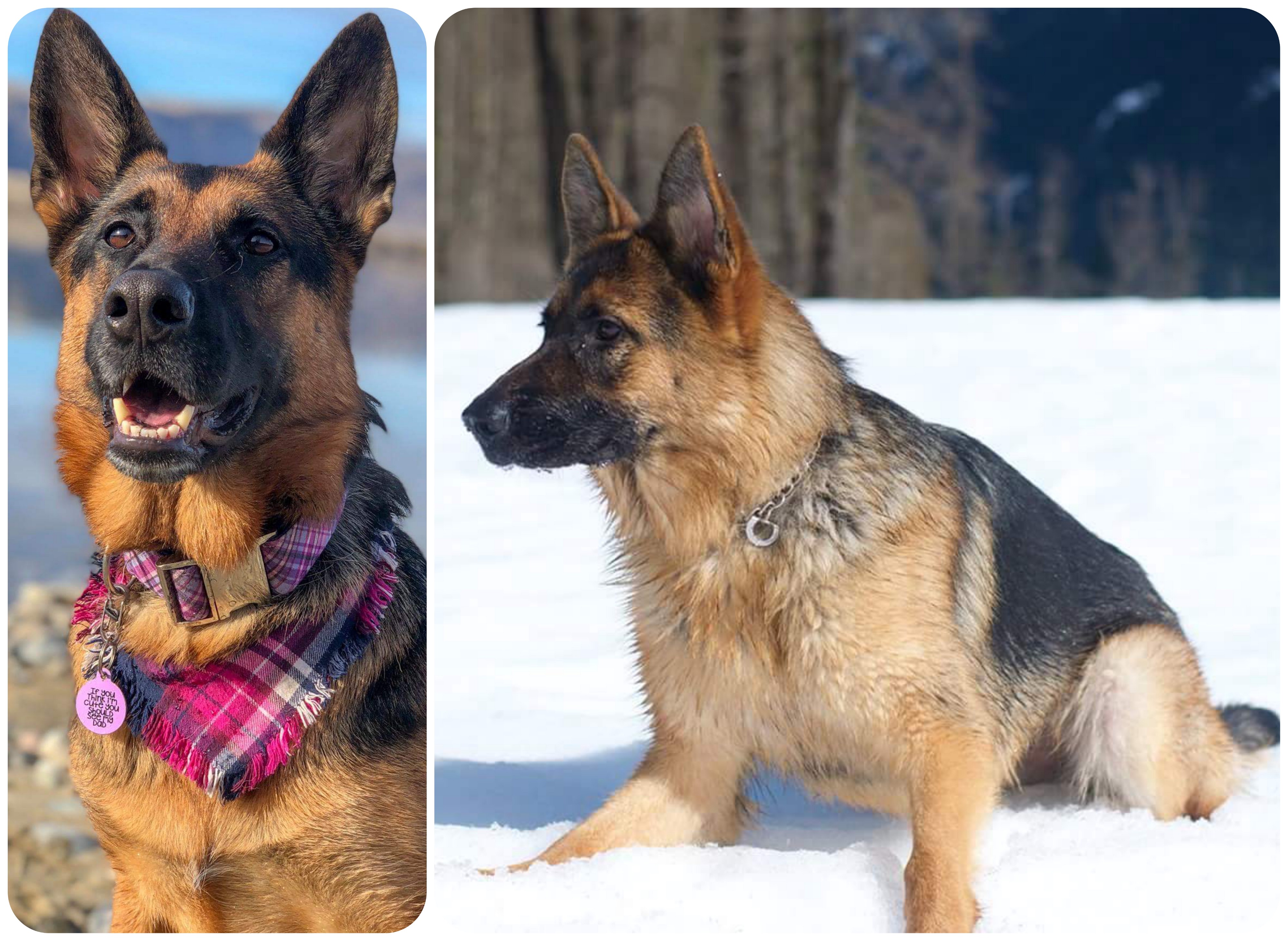 Anya (@anya_and_aero) on the left is a deep red, while Guiness (@guiness_the_gsd) on the right is a lighter tan. Anya is at/at while Guiness is at/a.
Anya (@anya_and_aero) on the left is a deep red, while Guiness (@guiness_the_gsd) on the right is a lighter tan. Anya is at/at while Guiness is at/a.
A white German Shepherd?s Intensity Locus has dialed their Phaeomelonin all the way down to nothing, but what if they weren?t e/e and could still produce Eumelanin? In breed terms, we typically call these GSDs Silver in color, such as a Silver Sable GSD or a Black and Silver GSD.
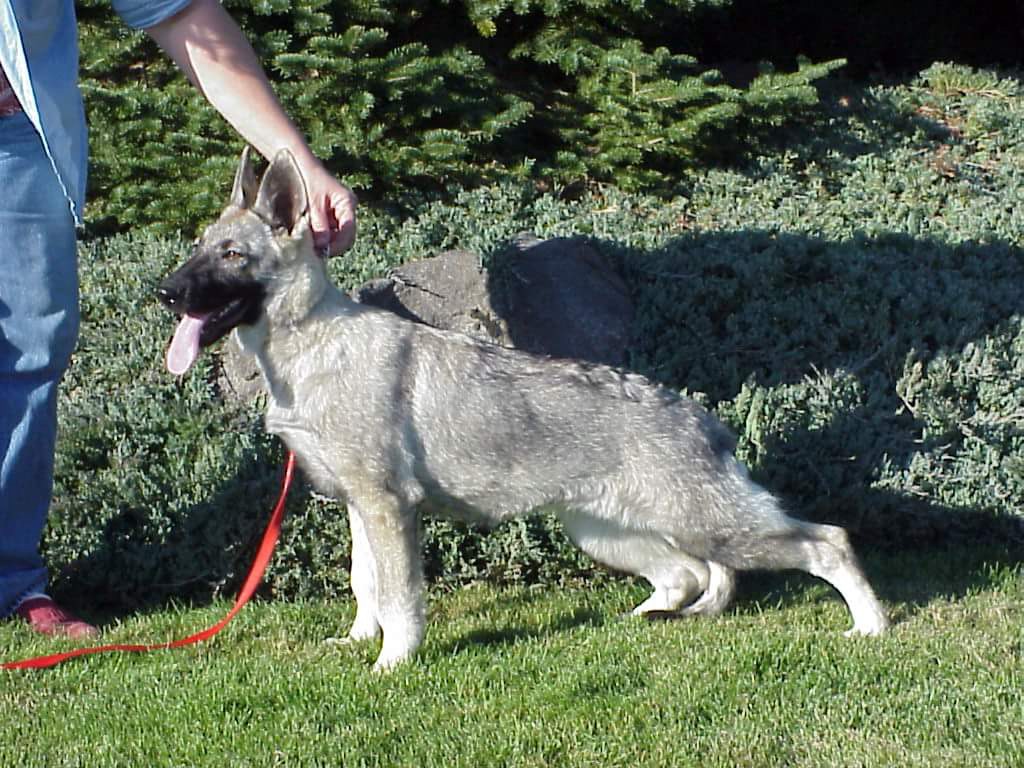 Liesel, around 1 year old in this picture, is a Silver Sable. Her sire was aw/aw e/e and her Dam a/a Em/e.
Liesel, around 1 year old in this picture, is a Silver Sable. Her sire was aw/aw e/e and her Dam a/a Em/e.
One last interesting example with the Intensity Locus. Given what I?ve said about the Intensity Locus, you can probably guess that there are several other breeds where e/e is common, but the Intensity Locus is set to produce lots of Phaeomelanin. The first example that comes to mind is probably the Golden Retriever. 100% of Golden Retrievers are e/e, with different levels of intensity controlling their color from red to cream. But what about German Shepherds? What does an e/e German Shepherd look like when they can still produce Phaeomelanin?
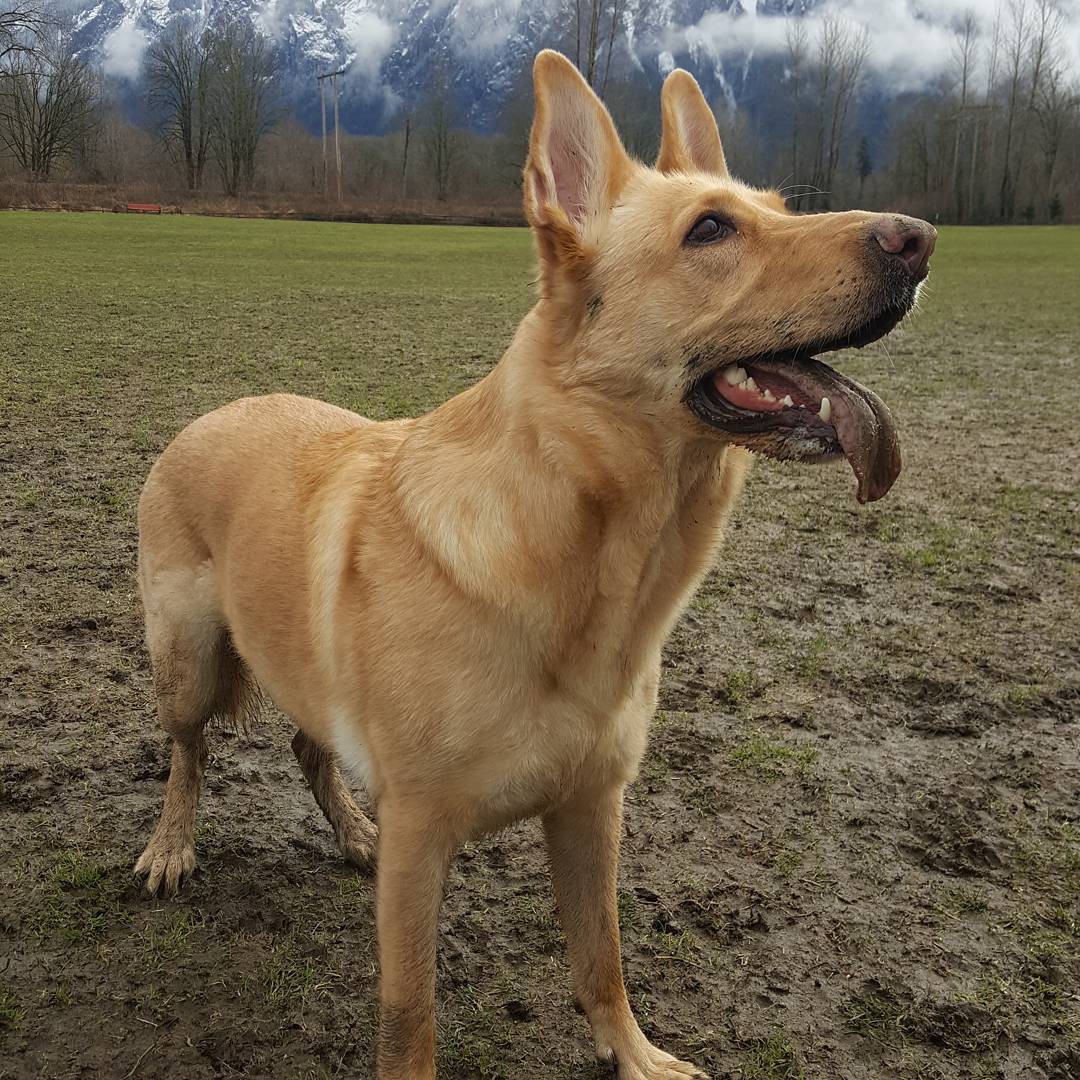 This is Mya, the e/e GSD with tan Phaeomelanin. Follow her on Instagram @pawsitively_mya
This is Mya, the e/e GSD with tan Phaeomelanin. Follow her on Instagram @pawsitively_mya
What does this mean for the charts above?
Because the genetics behind the I Locus aren?t fully understood, it?s not entirely predictable how our predictions will change. Based on experience from breeders, we can be fairly certain that the genes that fade Phaeomelanin all the way to white are recessive. In this way, if the black dog in our example carries both 1 copy of e AND 1 copy of this lighter Phaeomelanin, then some of our combinations above may result in Silver Sables or black and silvers.
Liver, Blue and Isabella
Similar to how the Intensity Locus impacts Phaeomelanin (red), there are 2 known and fully mapped genes that control the intensity of Eumelanin (black).
Brown (B) Locus: Known as Liver in German Shepherds, this makes the Eumelanin a dog produces look brown. It?s also what causes a Chocolate Lab to look brown instead of black. For our purposes, there are 2 alleles to the B locus:
- B, with even 1 copy of this Dominant allele the dog is not impacted by this gene and, barring other genes, can produce Eumelanin.
- b, with 2 copies of this recessive allele, the dog cannot produce ANY black anywhere on their body, it will always be Liver.
Dilute (D) Locus: Known as Blue in German Shepherds, this causes the Eumelanin a dog produces to look faded or diluted. As with the B Locus, there are 2 alleles for this gene:
- D, with even 1 copy of this Dominant allele the dog is not impacted by this gene and, barring other genes, can produce Eumelanin.
- d, with 2 copies of this recessive allele, the dog cannot produce ANY black anywhere on their body, it will always be blue/diluted instead.
Isabella is the name given to a dog that is both b/b and d/d.
While Phaeomelanin is only produced in a dog?s fur, however Eumelanin is produced in several other parts of body including the lips, nose and eyes. This means that genes that impact the color of Eumelanin also impact the color of these other parts of the body in addition to the coat. For this reason, dogs with either b/b or d/d will typically have very light eyes, borderline yellow instead of brown in some cases.
What does this mean for the charts above?
Since Blue and Liver are caused by entirely different genes, they mean that for every single one of our combinations, there is a version where both parents carry for Blue (D/d), carry for Liver (B/b) or for both (B/b D/d). If both parents carry, then there is a 25% chance that any given puppy will inherit a copy from each parent and will also be Blue, Liver or Isabella. If the puppy is also e/e and white, then this will only be visible through the puppy?s eyes, lips and nose. The lips are the safest way to tell, as there are many reasons a dog?s nose could turn pink over time and this seems to be a common occurrence in white GSDs.
Bi-Color, Black and Tan, and Bleed Through
In the GSD world, there is a pattern explicitly called ?Bi-color?. In other breeds, this is often referred to as Tan Point. It?s characterized by a dog that is predominantly black, with stripes of tan going up the backs of its legs. These dogs often have tan eye brows. On some websites, you?ll find the statement that Bi-color GSDs are at/a or at/at and that traditional saddle patch German Shepherds are ?as/as?. The reason for this statement is that it was once theorized that the saddle was caused by an as yet unmapped Agouti allele, however further researched showed this not to be true.
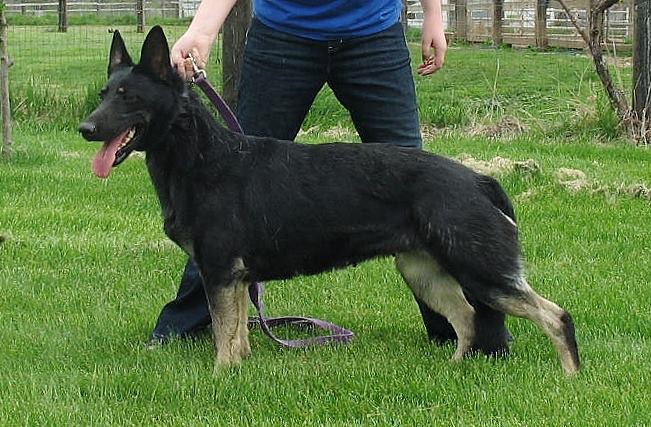 Kate here loves to confuse people! She?s a/a on her Agouti Locus, despite visually appearing to be at/a or at/at!
Kate here loves to confuse people! She?s a/a on her Agouti Locus, despite visually appearing to be at/a or at/at!
To confuse matters further, some Bi-color GSDs have come back as a/a, where the tan on their legs is caused by an effect referred to as ?bleed through?. Bleed through typically means tan or white showing through in a section of coat that is otherwise black. In Kate?s case, this bleed through is so significant that there is no black left in large patches and she is commonly mistaken for being at/a, despite 2 different labs testing her as a/a.
Panda and white spotting in German Shepherds
Panda is a unique mutation that occurred on a single individual dog that causes what is called ?white spotting? on German Shepherds. UC Davis has released several papers on the mutation itself, and even offers a DNA test kit to verify if a given dog has the mutation or not. Panda is a dominant trait, which means it can never be ?carried? by a dog, it?s always expressed.
What does this mean for the charts above?
Annoyingly, for the purposes of our thought exercise, Panda can unfortunately be hidden underneath e/e in a White GSD. This would lead to yet another set of permutations, to our charts, where we would see a mixture of bi and tri colored Pandas depending on the A Locus a given Puppy has.
Bonus Round: How could 2 Solid black dogs produce white puppies?
It?s a lot easier than it seems. Since both black dogs are solid black, we know their A Locus must be a/a. But what about their E Locus? If both dogs are Em/e, then the breakdown looks like this:
 Each puppy would have a 75% chance of being solid black, and a 25% chance of being solid white!
Each puppy would have a 75% chance of being solid black, and a 25% chance of being solid white!
